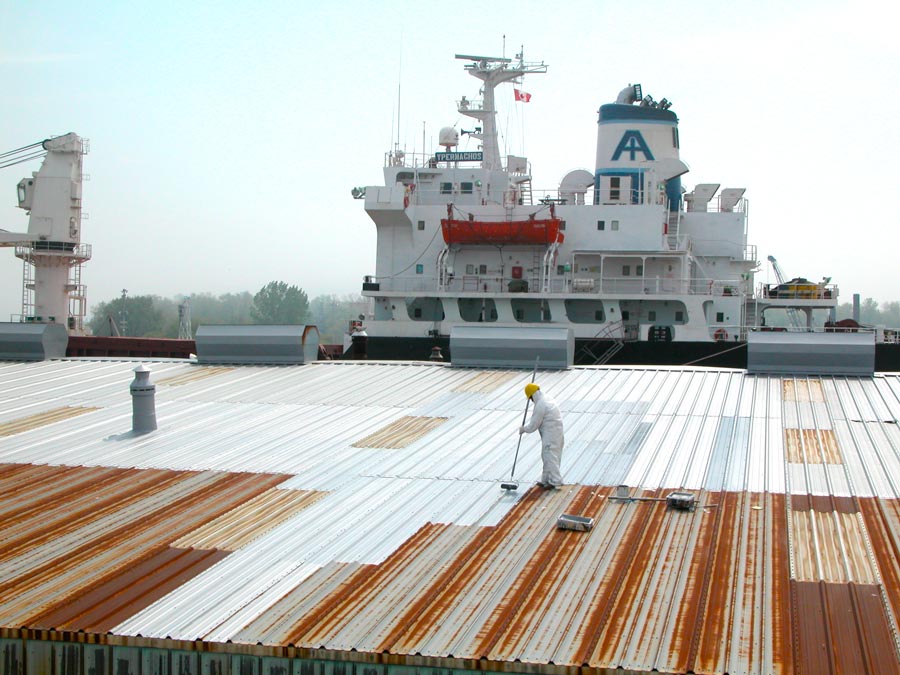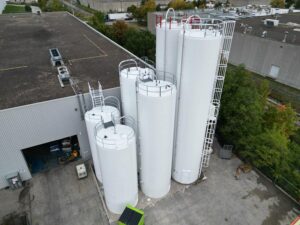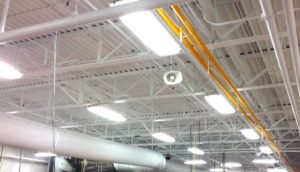In the realm of property management and maintenance, ensuring the longevity and resilience of your building’s infrastructure is paramount, and mastering metal roofing is a key component of this endeavor. Metal roof painting and refinishing not only enhance the aesthetic appeal of your building but also offer substantial benefits of metal roof maintenance, such as increased durability and energy efficiency. With the right approach to roof rejuvenation, property managers and plant maintenance professionals can significantly extend the lifespan of their metal roofs, ultimately boosting property value and reducing long-term costs. This essential guide will navigate through the intricacies of painting and refinishing, providing insights and best practices to help you achieve optimal metal roof longevity. Whether you’re managing a large commercial complex or a residential property, understanding these techniques can transform your roof into a robust and reliable asset. For more information on painting metal roofs, check out this comprehensive article.
Understanding Metal Roof Painting
Metal roof painting is a crucial aspect of maintaining the integrity and longevity of your roofing system. This section will explore the concept of painting, its importance, and best practices to ensure optimal results.
What is Metal Roof Painting?
Metal roof painting is the process of applying a new protective layer to an existing metal roof surface. This technique helps to restore and enhance the roof’s protective properties, extending its lifespan and improving its performance.
The painting process typically involves cleaning the roof surface, addressing any existing damage, and then applying a specialized coating material. This new layer acts as a barrier against environmental factors such as UV rays, moisture, and pollutants.
Painting can be done with various materials, including acrylic, silicone, or polyurethane-based coatings. Each type offers specific benefits and is chosen based on the roof’s condition, climate, and desired outcome.
Importance of Regular Painting
Regular painting is essential for maintaining the integrity and performance of metal roofs. It offers numerous benefits that contribute to the overall longevity and efficiency of the roofing system.
Firstly, painting helps prevent corrosion and rust, which are common issues with metal roofs exposed to the elements. By creating a protective barrier, the coating shields the metal from moisture and other corrosive agents.
Secondly, painting can improve energy efficiency by reflecting solar radiation, potentially reducing cooling costs in warmer climates. This reflective property also helps mitigate the urban heat island effect in densely populated areas.
Lastly, regular painting can significantly extend the lifespan of a metal roof, potentially doubling its service life when done properly and at appropriate intervals.
Best Practices for Painting
To ensure the best results when painting a metal roof, it’s crucial to follow industry-recommended best practices. These guidelines help maximize the effectiveness and longevity of the painting process.
- Thoroughly inspect the roof before painting to identify and address any existing damage or issues.
- Clean the roof surface meticulously to remove dirt, debris, and any loose or flaking paint.
- Choose the appropriate coating material based on the roof’s condition, local climate, and specific needs.
It’s also important to consider the timing of the painting process. Ideal conditions include dry weather with moderate temperatures. Avoid painting during extremely hot or cold periods, or when rain is forecasted.
Professional application is often recommended to ensure proper coverage and adherence to manufacturer specifications. This can help avoid common pitfalls and ensure the best possible outcome for your metal roof painting project.
Exploring Metal Roof Refinishing
Metal roof refinishing goes beyond simple painting, often involving more comprehensive restoration techniques. This section will delve into the refinishing process, necessary tools and materials, and how to choose the right finish for your metal roof.
Process of Metal Roof Refinishing
Metal roof refinishing is a comprehensive process that involves restoring the roof to a like-new condition. It typically includes more extensive preparation and restoration steps compared to basic painting.
The process usually begins with a thorough inspection to assess the roof’s condition and identify any areas requiring repair. This is followed by extensive cleaning, often using pressure washing techniques to remove all dirt, debris, and any loose or failing coatings.
Next, any damaged areas are repaired. This may involve patching holes, replacing fasteners, or addressing areas of rust or corrosion. Once repairs are complete, a primer is often applied to ensure good adhesion of the new finish.
Finally, the new finish is applied. This may be done in multiple layers, depending on the product used and the desired outcome. The finish not only enhances the appearance of the roof but also provides crucial protection against the elements.
Tools and Materials Needed
Proper tools and materials are essential for a successful metal roof refinishing project. Having the right equipment ensures efficiency and quality in the refinishing process.
Key tools often include:
- Pressure washer for thorough cleaning
- Wire brushes and scrapers for removing loose paint or rust
- Caulking guns for sealing joints and fasteners
- Paint rollers, brushes, or sprayers for applying coatings
Materials typically required are:
- Cleaning solutions suitable for metal surfaces
- Rust inhibitors or converters
- Patching compounds for repairs
- Primer specifically designed for metal roofs
- High-quality metal roof coating or paint
It’s important to choose materials that are compatible with the existing roof surface and suitable for the local climate. Always follow manufacturer recommendations for best results.
Choosing the Right Finish
Selecting the appropriate finish is crucial for the success and longevity of your metal roof refinishing project. The right choice depends on various factors including the roof’s condition, local climate, and desired aesthetic and functional outcomes.
Common finish options include:
- Acrylic coatings: Offer good UV resistance and are cost-effective
- Silicone coatings: Provide excellent waterproofing and weather resistance
- Polyurethane coatings: Offer superior durability and chemical resistance
Consider the following when choosing a finish:
- Climate conditions (e.g., high UV exposure, frequent rain)
- Roof slope and drainage patterns
- Energy efficiency goals (e.g., cool roof coatings for heat reflection)
- Color and aesthetic preferences
Consulting with a roofing professional can help in making an informed decision that balances performance, longevity, and cost-effectiveness for your specific metal roof.
Benefits of Metal Roof Maintenance
Regular maintenance of metal roofs offers numerous advantages, from extending the roof’s lifespan to providing cost savings and environmental benefits. This section explores these key benefits in detail.
Enhancing Metal Roof Longevity
Proper maintenance is key to enhancing the longevity of metal roofs. Regular care and timely interventions can significantly extend the life of your roofing system, ensuring it continues to protect your property for years to come.
One of the primary ways maintenance enhances longevity is by preventing small issues from escalating into major problems. Regular inspections can identify potential weak points, such as loose fasteners or small leaks, allowing for prompt repairs before they cause significant damage.
Maintenance also helps preserve the protective coatings on metal roofs. These coatings shield the metal from corrosive elements, UV radiation, and moisture. By maintaining these coatings through regular cleaning and reapplication when necessary, you can significantly extend the roof’s effective lifespan.
Moreover, proper maintenance can help a metal roof maintain its structural integrity over time. This includes ensuring proper drainage, preventing the buildup of debris, and addressing any issues with thermal expansion and contraction.
Cost-Effectiveness of Regular Maintenance
Regular maintenance of metal roofs is not just about preserving the roof; it’s a cost-effective strategy that can save property owners significant amounts of money in the long run.
Firstly, maintenance helps avoid costly repairs or premature roof replacement. By addressing small issues early, you prevent them from developing into major problems that require extensive and expensive repairs.
Secondly, a well-maintained metal roof can improve energy efficiency. Proper maintenance, including regular cleaning and painting, helps maintain the roof’s reflective properties, potentially reducing cooling costs in warmer months.
Lastly, regular maintenance can positively impact property value. A well-maintained roof is an asset when selling a property, potentially increasing its market value and attractiveness to buyers.
| Maintenance Action | Potential Cost Savings |
| Regular Inspections | Prevents major repairs |
| Timely Repairs | Extends roof lifespan |
| Painting | Improves energy efficiency |
| Cleaning | Maintains reflective properties |
Environmental Benefits
Maintaining metal roofs not only benefits the property owner but also contributes to environmental sustainability. These environmental advantages make metal roofs an eco-friendly choice when properly maintained.
One significant benefit is the reduction of waste. By extending the life of the roof through proper maintenance, fewer materials end up in landfills. Metal roofs are also often made from recycled materials and are fully recyclable at the end of their life, further reducing environmental impact.
Well-maintained metal roofs can also contribute to energy efficiency. Reflective coatings, when kept clean and in good condition, can significantly reduce the heat absorbed by the building, potentially lowering energy consumption for cooling.
Additionally, properly maintained metal roofs can support rainwater harvesting systems more effectively, promoting water conservation. They also provide an excellent base for solar panel installations, facilitating the adoption of renewable energy sources.
Techniques for Roof Rejuvenation
Rejuvenating a metal roof involves a series of techniques designed to restore its condition and enhance its performance. This section covers essential steps in the rejuvenation process, from cleaning and preparation to addressing common issues.
Cleaning and Prep Work Essentials
Proper cleaning and preparation are crucial first steps in any roof rejuvenation project. These processes ensure that the roof surface is ready to receive new coatings or treatments effectively.
The cleaning process typically involves:
- Removing loose debris with brooms or leaf blowers
- Applying a suitable cleaning solution to break down dirt and grime
- Pressure washing the surface to remove all contaminants
- Allowing the roof to dry completely before further treatment
Preparation work may include:
- Addressing any rust spots with wire brushing and rust converter application
- Tightening or replacing loose fasteners
- Sealing any gaps or seams with appropriate caulking materials
It’s important to follow safety protocols during these processes, including using proper fall protection equipment and ensuring the pressure washer is used correctly to avoid damaging the roof surface.
Applying Protective Coatings
Applying protective coatings is a key step in roof rejuvenation, providing a new layer of defense against the elements and extending the roof’s lifespan.
The coating process typically involves:
- Applying a primer (if required) to ensure good adhesion
- Using rollers, brushes, or sprayers to apply the chosen coating evenly
- Allowing proper drying time between coats as per manufacturer instructions
- Applying multiple coats if necessary for optimal protection
It’s crucial to choose the right type of coating based on the roof’s condition and local climate. Options may include:
- Acrylic coatings for general protection and UV resistance
- Silicone coatings for superior waterproofing
- Polyurethane coatings for high-traffic areas or severe weather conditions
Always follow the manufacturer’s guidelines for application techniques and coverage rates to ensure the best results and longevity of the protective coating.
Addressing Common Roof Issues
During the rejuvenation process, it’s important to address common issues that may affect the performance and longevity of metal roofs.
Some frequent problems include:
- Leaks at seams or fasteners
- Corrosion or rust spots
- Damage from impacts or foot traffic
- Thermal expansion and contraction issues
Addressing these issues may involve:
- Resealing seams and around penetrations with appropriate sealants
- Treating corroded areas with rust converters and protective coatings
- Reinforcing damaged areas with patches or overlay systems
- Installing expansion joints to accommodate thermal movement
It’s often beneficial to consult with a roofing professional to ensure all issues are properly identified and addressed. This comprehensive approach helps ensure that the rejuvenation process results in a roof that not only looks renewed but also functions optimally for years to come.
Planning for Long-Term Roof Care
Effective long-term care of metal roofs requires strategic planning and professional expertise. This section focuses on creating maintenance schedules, understanding professional services, and evaluating the costs and benefits of ongoing roof care.
Creating a Maintenance Schedule
Developing a comprehensive maintenance schedule is crucial for ensuring the longevity and performance of your metal roof. A well-planned schedule helps prevent issues before they arise and keeps your roof in optimal condition.
Key elements of a maintenance schedule include:
- Regular inspections (at least twice a year, typically in spring and fall)
- Routine cleaning to remove debris and prevent water pooling
- Checks for loose fasteners, sealant degradation, and coating wear
- Gutter and drainage system cleaning and maintenance
It’s important to tailor the schedule to your specific roof and local climate conditions. For instance, roofs in areas with heavy snowfall may require additional inspections after winter, while those in coastal areas might need more frequent checks for salt-air corrosion.
Consider creating a checklist for each inspection to ensure all critical areas are examined consistently. This can help track the roof’s condition over time and identify trends or recurring issues that may need attention.
Professional Services for Metal Roofing
While some maintenance tasks can be performed by property owners, professional services play a crucial role in comprehensive metal roof care. Experienced roofing professionals bring specialized knowledge and equipment to ensure thorough maintenance and repairs.
Professional services often include:
- Detailed roof inspections using advanced techniques (e.g., infrared scanning)
- Expert application of coatings and sealants
- Specialized repairs for complex issues
- Advice on long-term maintenance strategies
When selecting a roofing professional, consider:
- Experience specifically with metal roofing systems
- Certifications and training from reputable industry organizations
- References and examples of similar projects
- Warranty offerings for their work
Regular engagement with professional services can help catch potential issues early, ensure proper maintenance techniques are used, and provide peace of mind regarding the condition of your roof.
Evaluating Cost vs. Benefits
Assessing the costs and benefits of long-term metal roof care is essential for making informed decisions about maintenance investments. While regular maintenance does incur ongoing costs, it often results in significant long-term savings and benefits.
Consider the following factors:
- Initial costs of maintenance vs. potential repair or replacement costs
- Energy savings from a well-maintained, reflective roof
- Extended lifespan of the roofing system
- Potential increase in property value
Remember that the costs of neglect can far outweigh the expenses of regular maintenance. A well-maintained metal roof can last 50 years or more, while a neglected one might need replacement in half that time.
Ultimately, viewing roof maintenance as an investment rather than an expense can help justify the costs and ensure your metal roof continues to protect and add value to your property for many years to come.





